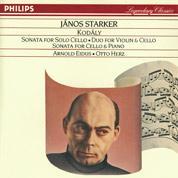In 1950 cellist János Starker made a group of LP recordings for the Period label, eventually reissued in 2007 as a pair of double-CD sets. However, in 1989 Philips also mined this material for a single-CD release featuring Kodály’s three major cello works, a recording that has long been out of print but now returns to the catalog courtesy of Arkivmusic.com’s on-demand reprint program.
Despite Philips’ use of the controversial “No Noise” restoration technology, its transfers prove far more vibrant and detailed than their 2007 counterparts, despite a slightly metallic edge to the upper strings in the Solo Sonata Op. 8. The two-movement Sonata for Cello and Piano Op. 4 receives a splendid interpretation. Both Starker and pianist Otto Herz toss the Allegro con spirito’s motives back and forth with impeccably balanced repartée. You also hear how the 26-year-old Starker’s big tone, sensitivity to nuance, and tasteful control triumphantly mesh in the Fantasie movement’s unaccompanied passages, while Herz is an incisive yet always singing collaborative pianist; even his marcatos have lung power.
Collectors familiar with the live Starker/Josef Gingold performance of the Op. 7 Duo for Violin and Cello will find the cellist’s 1950 partnership with violinist Arnold Eidus no less rewarding, and arguably more effective by virtue of the Adagio’s greater animation. The winner of the 1946 Jacques Thibaud International Competition, Eidus was a great all-around musician at home in many styles, and was one of the New York studio scene’s key players; it’s good to have a reminder of his distinguished career.
Had Starker left no other recording of the Solo Sonata, this 1950 version still would stand out for its impetuous, impassioned sweep in the outer movements and the vocal quality of the central Adagio’s long, sustained lower-register passages. The latter movement’s rapid figurations above the staff would gain suppleness and rock-solid intonation in Starker’s two later traversals. And by the time of his fourth and final recording of this work, Starker would bring flexibility and character to the finale’s folk-inspired tunes, as well as restoring the 52-measure sequence of mostly arpeggiated figures that he omitted in his previous recordings. In fact, you actually hear the sound of pages turning just before the cut in the 1950 recording.
The important thing is that these performances raised awareness of Kodály’s cello works in the early LP era, helped establish Starker’s reputation, and ought to be heard by anyone remotely interested in the cellist. I hope Arkivmusic.com will reprint Starker’s extremely rare 1984 Bach Cello Suites cycle released on the Sefel label.
































